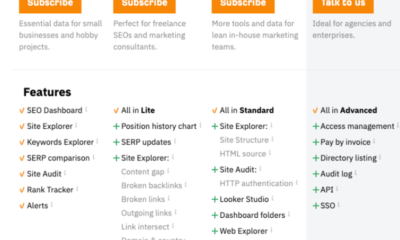Politics
5 Ways Digitization Is Impacting Your World
Published
2 years agoon
By
Drew Simpson
Have you ever stopped to consider just how much digitization is impacting your world? Like most people, you probably spend your days moving from moment to moment. You run personal errands. You check off another “to-do” item from your growing list. But do you stop to think about how the products and services you’re interacting with work?
Probably not, and that’s okay. However, if you just scratched the surface, you’d find that many of the processes you use daily rely on digital innovations. Without a doubt, digitization is impacting your world by making routine tasks so much easier. Below are just a few of the everyday, seemingly mundane (but vitally important) processes making the most of technology.
1. Financial Transactions
You’ve just bought something online to pick up at your leisure from Walmart. The transaction took seconds to set up.
How is the cash flowing from one account to another, though? It’s likely riding on financial rails set up by companies such as FIS. Without a doubt, one of the biggest ways that digitization is impacting your world is by facilitating safe, rapid payment processes.
FIS provides behind-the-scenes digital pathways to move money. That way, you’re able to purchase a last-minute Halloween costume or pay for your Uber. FIS strives to make money move as quickly as possible.
The company’s ultimate goal? Real-time transactions that lower payment friction points even more. Their recent partnership with the Washington Nationals is showcasing what all these tools used at once can do to personalize fan experience, eliminate wait times and activate live in-game betting from the stadium.
Looking toward the future, blockchain seems to be a possible next-gen step for the financial services and transaction industries. With its decentralized structure, blockchain may be a way for digital currency to travel between B2C or B2B parties.
In the meantime, though, the digital developments that have occurred in finance so far fit consumers’ desire to make payments rapidly and, when desired, in a contactless manner.
2. Data Collection
You already know that digital tools help collect and sort data. What you might not realize is how valuable technically-driven data collection can be.
For one, it reduces the need for people to manually transfer data across systems, as in the case of IBML’s use case with the airline industry. IBML’s engineers figured out how to use software to extract data from airport tickets and convert the data into usable knowledge. The company’s experiences led it to become the intelligent document processing provider of choice for many institutions.
The second advantage to being able to rely on data collection comes when you need help from a customer service representative.
Thanks to the sophisticated software used in so many corporations today, your support agent can quickly resolve your issues. How? Your previously collected information is run through AI-fueled algorithms that give the agent suggestions to make things right for you.
A final upshot to advanced data collection is that it allows businesses to spot trends sooner. If you’re a founder, CEO, or CMO, you know the importance of being first to market with evolving concepts.
3. Supply Chain Management
Of course, you realize that when you order food from Chipotle’s app that you’re working within a digital realm.
There’s much more happening from Chipotle’s point of view than from yours. Chipotle is one of several brands working with Semarchy to streamline supply chain snags.
Since the beginning of the pandemic, supply chains have experienced major breakdowns. Semarchy’s data management tool helps businesses such as Chipotle use data wisely. By analyzing data for trends, Semarchy’s tool can tell Chipotle what resources it needs and when it needs them. This enables Chipotle to know exactly where to route supplies so that customers like you are happy.
Supply chain management isn’t limited to the fast-food sector, of course.
Practically every business has some kind of a supply chain. Systems that can relay data in real-time can help companies make wiser buying, transportation, and related choices that take some of the pain out of the supply chain disruptions that are expected to last until at least 2023.
4. Customer Service
The chatbots are having their day—or, rather, the inventors of chatbot technology.
In 2022, the business market for AI-powered chatbots is predicted to reach $7 billion. Though some chatbot interfaces are still a bit halting and clunky, they’re getting better all the time. In fact, you may fall into the category of people who have chatted with a bot and didn’t know it!
Digitization is making chatbot technology adapt more quickly to the needs of humans. Today’s chatbots frequently are embedded with machine learning. This means they increase their ability to respond appropriately with every engagement. Almost like humans, they learn from their interactions.
It’s not hard to spot when you’re chatting with a bot, of course. There are some telltale signs, like an odd use of semantics from time to time.
With that being said, chatbot tech is becoming extremely sophisticated. Some chatbots have learned to add pauses or use colloquialisms. So the next time you want to chat with an online support rep, know that you might be conversing with a bot. (But you can usually ask to speak with a live representative during regular business hours if needed!)
5. Payroll
Do you imagine that your supervisor or the “big boss” signs off on your paycheck? Or that your human resources team calculates all your federal, state, and local taxes by hand?
That might be true if you work for a very small organization or receive handwritten checks. However, in today’s digital age, your employer may never directly see anything but an after-the-fact report regarding payroll.
The truth is that tons of companies of all sizes rely on digitized payroll solutions. Many turn to cloud-based providers. That way, they don’t have to worry about upgrades or IT. Once they (or you) input your information into the payroll management system, your paychecks will come just like clockwork.
It’s fast, convenient, and secure. Plus, you don’t have to worry that someone forgot to initiate a transaction—which could hold up your pay. And your company won’t overspend on payroll tasks.
Let’s put the cost savings of payroll software solutions into perspective.
A quarter of small business owners spend upwards of 60 hours annually on the payroll. That’s time they could put into profit-producing responsibilities and efforts. By leveraging digitized payroll systems, they can reduce their need to be too hands-on. And bosses who still want to give payroll “one last look” can set up automatic sign-up workflows.
The ways that digitization is impacting your world aren’t limited to the obvious. It’s happening all around us and changing the way we interact with the world. With the growth of digital transformations in all sectors, it’s bound to become even more widespread in the coming years.
Image Credit: Jack Sparrow; Pexels.com.
Deanna Ritchie
Managing Editor at ReadWrite
Deanna is the Managing Editor at ReadWrite. Previously she worked as the Editor in Chief for Startup Grind and has over 20+ years of experience in content management and content development.
You may like
-


Four ways AI is making the power grid faster and more resilient
-


Plastic is a climate change problem. There are ways to fix it.
-


15 Proven Ways to Increase Customer Engagement and Build Loyalty
-


Four Clever Ways to Use Tiered Pricing for Maximum Profit
-


5 Ways to Reduce Customer Churn
-


SMBs Path to Digitization: How Can Technology Solutions Providers Help?
Politics
Fintech Kennek raises $12.5M seed round to digitize lending
Published
7 months agoon
10/11/2023By
Drew Simpson
London-based fintech startup Kennek has raised $12.5 million in seed funding to expand its lending operating system.
According to an Oct. 10 tech.eu report, the round was led by HV Capital and included participation from Dutch Founders Fund, AlbionVC, FFVC, Plug & Play Ventures, and Syndicate One. Kennek offers software-as-a-service tools to help non-bank lenders streamline their operations using open banking, open finance, and payments.
The platform aims to automate time-consuming manual tasks and consolidate fragmented data to simplify lending. Xavier De Pauw, founder of Kennek said:
“Until kennek, lenders had to devote countless hours to menial operational tasks and deal with jumbled and hard-coded data – which makes every other part of lending a headache. As former lenders ourselves, we lived and breathed these frustrations, and built kennek to make them a thing of the past.”
The company said the latest funding round was oversubscribed and closed quickly despite the challenging fundraising environment. The new capital will be used to expand Kennek’s engineering team and strengthen its market position in the UK while exploring expansion into other European markets. Barbod Namini, Partner at lead investor HV Capital, commented on the investment:
“Kennek has developed an ambitious and genuinely unique proposition which we think can be the foundation of the entire alternative lending space. […] It is a complicated market and a solution that brings together all information and stakeholders onto a single platform is highly compelling for both lenders & the ecosystem as a whole.”
The fintech lending space has grown rapidly in recent years, but many lenders still rely on legacy systems and manual processes that limit efficiency and scalability. Kennek aims to leverage open banking and data integration to provide lenders with a more streamlined, automated lending experience.
The seed funding will allow the London-based startup to continue developing its platform and expanding its team to meet demand from non-bank lenders looking to digitize operations. Kennek’s focus on the UK and Europe also comes amid rising adoption of open banking and open finance in the regions.
Featured Image Credit: Photo from Kennek.io; Thank you!
Radek Zielinski
Radek Zielinski is an experienced technology and financial journalist with a passion for cybersecurity and futurology.
Politics
Fortune 500’s race for generative AI breakthroughs
Published
7 months agoon
10/11/2023By
Drew Simpson
As excitement around generative AI grows, Fortune 500 companies, including Goldman Sachs, are carefully examining the possible applications of this technology. A recent survey of U.S. executives indicated that 60% believe generative AI will substantially impact their businesses in the long term. However, they anticipate a one to two-year timeframe before implementing their initial solutions. This optimism stems from the potential of generative AI to revolutionize various aspects of businesses, from enhancing customer experiences to optimizing internal processes. In the short term, companies will likely focus on pilot projects and experimentation, gradually integrating generative AI into their operations as they witness its positive influence on efficiency and profitability.
Goldman Sachs’ Cautious Approach to Implementing Generative AI
In a recent interview, Goldman Sachs CIO Marco Argenti revealed that the firm has not yet implemented any generative AI use cases. Instead, the company focuses on experimentation and setting high standards before adopting the technology. Argenti recognized the desire for outcomes in areas like developer and operational efficiency but emphasized ensuring precision before putting experimental AI use cases into production.
According to Argenti, striking the right balance between driving innovation and maintaining accuracy is crucial for successfully integrating generative AI within the firm. Goldman Sachs intends to continue exploring this emerging technology’s potential benefits and applications while diligently assessing risks to ensure it meets the company’s stringent quality standards.
One possible application for Goldman Sachs is in software development, where the company has observed a 20-40% productivity increase during its trials. The goal is for 1,000 developers to utilize generative AI tools by year’s end. However, Argenti emphasized that a well-defined expectation of return on investment is necessary before fully integrating generative AI into production.
To achieve this, the company plans to implement a systematic and strategic approach to adopting generative AI, ensuring that it complements and enhances the skills of its developers. Additionally, Goldman Sachs intends to evaluate the long-term impact of generative AI on their software development processes and the overall quality of the applications being developed.
Goldman Sachs’ approach to AI implementation goes beyond merely executing models. The firm has created a platform encompassing technical, legal, and compliance assessments to filter out improper content and keep track of all interactions. This comprehensive system ensures seamless integration of artificial intelligence in operations while adhering to regulatory standards and maintaining client confidentiality. Moreover, the platform continuously improves and adapts its algorithms, allowing Goldman Sachs to stay at the forefront of technology and offer its clients the most efficient and secure services.
Featured Image Credit: Photo by Google DeepMind; Pexels; Thank you!
Deanna Ritchie
Managing Editor at ReadWrite
Deanna is the Managing Editor at ReadWrite. Previously she worked as the Editor in Chief for Startup Grind and has over 20+ years of experience in content management and content development.
Politics
UK seizes web3 opportunity simplifying crypto regulations
Published
7 months agoon
10/10/2023By
Drew Simpson
As Web3 companies increasingly consider leaving the United States due to regulatory ambiguity, the United Kingdom must simplify its cryptocurrency regulations to attract these businesses. The conservative think tank Policy Exchange recently released a report detailing ten suggestions for improving Web3 regulation in the country. Among the recommendations are reducing liability for token holders in decentralized autonomous organizations (DAOs) and encouraging the Financial Conduct Authority (FCA) to adopt alternative Know Your Customer (KYC) methodologies, such as digital identities and blockchain analytics tools. These suggestions aim to position the UK as a hub for Web3 innovation and attract blockchain-based businesses looking for a more conducive regulatory environment.
Streamlining Cryptocurrency Regulations for Innovation
To make it easier for emerging Web3 companies to navigate existing legal frameworks and contribute to the UK’s digital economy growth, the government must streamline cryptocurrency regulations and adopt forward-looking approaches. By making the regulatory landscape clear and straightforward, the UK can create an environment that fosters innovation, growth, and competitiveness in the global fintech industry.
The Policy Exchange report also recommends not weakening self-hosted wallets or treating proof-of-stake (PoS) services as financial services. This approach aims to protect the fundamental principles of decentralization and user autonomy while strongly emphasizing security and regulatory compliance. By doing so, the UK can nurture an environment that encourages innovation and the continued growth of blockchain technology.
Despite recent strict measures by UK authorities, such as His Majesty’s Treasury and the FCA, toward the digital assets sector, the proposed changes in the Policy Exchange report strive to make the UK a more attractive location for Web3 enterprises. By adopting these suggestions, the UK can demonstrate its commitment to fostering innovation in the rapidly evolving blockchain and cryptocurrency industries while ensuring a robust and transparent regulatory environment.
The ongoing uncertainty surrounding cryptocurrency regulations in various countries has prompted Web3 companies to explore alternative jurisdictions with more precise legal frameworks. As the United States grapples with regulatory ambiguity, the United Kingdom can position itself as a hub for Web3 innovation by simplifying and streamlining its cryptocurrency regulations.
Featured Image Credit: Photo by Jonathan Borba; Pexels; Thank you!
Deanna Ritchie
Managing Editor at ReadWrite
Deanna is the Managing Editor at ReadWrite. Previously she worked as the Editor in Chief for Startup Grind and has over 20+ years of experience in content management and content development.
